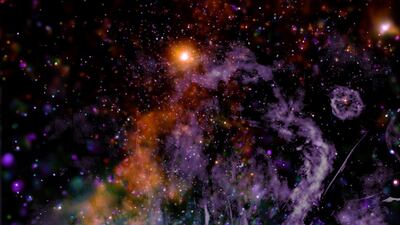Nasa has released a stunning picture of our galaxy’s violent, super-energised “downtown”.
It’s a composite of 370 observations over the past two decades from the orbiting Chandra X-ray Observatory, depicting billions of stars and countless black holes in the centre, or heart, of the Milky Way.
A radio telescope in South Africa also contributed to the image, for contrast.
Astronomer Daniel Wang of the University of Massachusetts Amherst said he spent a year working on this at home during the pandemic.
“What we see in the picture is a violent or energetic ecosystem in our galaxy’s downtown,” Mr Wang said. “There are a lot of supernova remnants, black holes and neutron stars there. Each X-ray dot or feature represents an energetic source, most of which are in the centre.”
This false-colour X-ray and radio frequency image show threads of superheated gas and magnetic fields at the centre of the Milky Way galaxy.
X-rays detected by the observatory are in orange, green, blue and purple, and radio data from the MeerKAT radio telescope in South Africa are shown in lilac and grey.
The plane of the galaxy is horizontal, in the centre of this vertical image.
This busy, high-energy galactic centre is 26,000 light years away.
Dr Wang's work appears in the June issue of the Monthly Notices of the Royal Astronomical Society.
Launched in 1999, the Chandra observatory is in an extreme oval orbit around Earth.
Read more on Space:
Plutonium discovered deep in the Pacific Ocean 'fell from space'
UAE's Hope probe sends back new images of Mars
China makes history with Mars rover landing
UAE’s lunar rover will use artificial intelligence to explore the Moon

